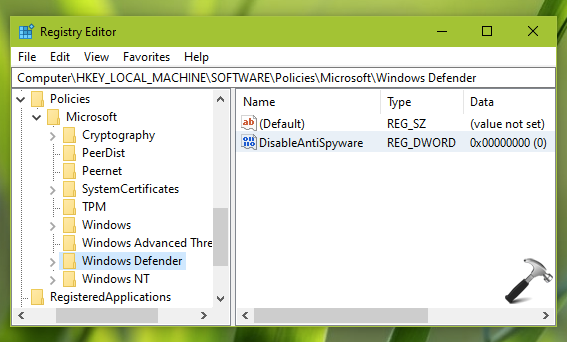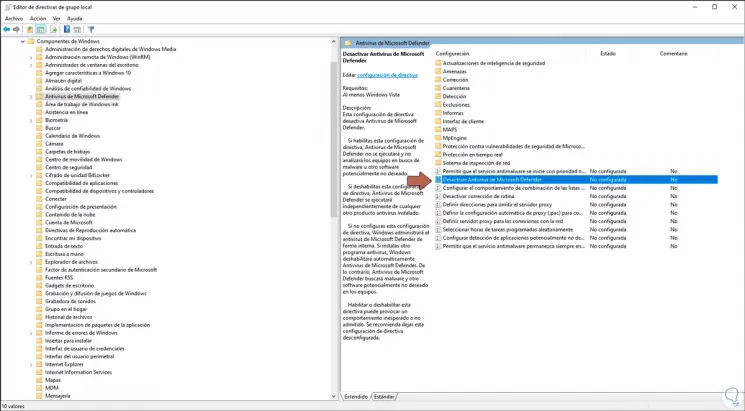41 windows defender antivirus service high memory
Windows 10 High Memory Usage [Causes and Solutions] Step 2: Run Windows Defender. Click Windows Defender and Open Windows Defender Security Center. Click Virus & threat protection and then click Quick scan. But there has been users reporting that antivirus programs, including Windows Defender may cause Windows 10 high memory usage. Nov 05, 2021 · For most people, the high memory usage caused by Antimalware Service Executable typically happens when Windows Defender is running a full scan. We can remedy this by scheduling the scans to take place at a time when you're less likely to feel the drain on your CPU.
[Fixed] Antimalware Service Executable High Disk Usage/CPU - EaseUS Follow the details below and fix the Antimalware Service Executable high disk usage issue. Step 1. Press Windows key + R at the same time to invoke the Run box. Type taskschd.msc and press Enter. Step 2. Double-click on "Task Scheduler Library" > "Microsoft" > "Windows". Step 3. Find and expand "Windows Defender".

Windows defender antivirus service high memory
5 Fixes to "Antimalware Service Executable High Disk Usage" Antimalware Service Executable process can cause high disk, CPU, or memory usage problems when running or updating. Typically, it automatically performs update or scan tasks in the background during the idle time of your computer. Sometimes, however, even if you're using a computer, it uses CPU resources to scan everything. Windows Defender (Real Time Protection) High Memory usage Windows Defender (Real Time Protection) High Memory usage. Noticed when playing Lego Star Wars recently, the game will eventually start stuttering. Opening task manager, I see Microsoft Defender Antivirus Service is using between 1GB - 3GB of memory. Disabling Real Time protection and enabling it again, puts it back to using a more reasonable ... Windows defender MsMpEng.exe and mssense.exe were high memory ... Try to open the task manager and then check whether or not Windows Defender process msmpeng.exe still occupies much CPU Disable Windows Defender in Group Policy: Local Group Policy > Computer Configuration > Administrative Templates > Windows Components > Windows Defender Antivirus.
Windows defender antivirus service high memory. Is the Antimalware Service Executable Hogging Your Memory? Here's How ... Navigate to HKEY_LOCAL_MACHINE > SOFTWARE > Microsoft > Windows Defender from the sidebar. Right-click on the Windows Defender folder and select New > DWORD (32-bit) Value. Enter DisableAntiSpyware in the Value name field and 1 in the Value data field. Press OK to save your changes and restart your system for the changes to take effect. How To Fix Antimalware Service Executable High Memory / CPU ... - YouTube This video will help you to Fix: 1) Antimalware Service Executable High Memory Usage on Windows 10 2) Antimalware Service Executable High CPU Usage on Windows 10 3) Disable Antimalware Service... Microsoft Defender Antivirus Service High Memory/ CPU/Disk ... Jun 14, 2022 · Generally, Microsoft Defender antivirus service high memory usage is triggered by the Real-time Protection feature in Windows Security. Therefore, it is a good option to disable it temporarily. Step 1. Click on the gearicon to open Windows Settings. Step 2. Locate to Update & Securityand hit it. Step 3. Fix problem with high CPU or high memory usage - Norton AntiVirus In the Norton Power Eraser window, select Full System Scan, and click Run Now. If you want to include the Rootkit scan, click Settings, and under Scan and Log Settings, toggle the option Include Rootkit scan (requires a computer restart) and click Apply. When you see a prompt to restart the computer, click Restart. Wait for the scan to complete.
How to stop antimalware service executable high memory? After that you will need to go to windows defender (security), press ransomware protection, enable Controlled Folder Access and select the drivers with the most important files for you or your family (if it's an family computeur). After that, every programm that it will try to access those folders will require premision by you. Windows Defender Memory Leak - Microsoft Tech Community Antimalware Service Executable is consuming a large amount of resources (~2-4GB of Memory) What I tried: I saw that it is a known issue and tried the solution I found ( here for example) but it didn't worked. I also noted that in fact the problem seems to be linked to the Automatic sample submission. How do I stop Windows Defender from using so much memory? How do I fix antimalware high RAM usage? — Disable Real Time Protection. … · Disable Scheduled Tasks. … · Install Another Antivirus Program. … · Permanently ... How to stop high CPU/Disk usage from "Antimalware Service ... - Gearbest Solution 3 - Disable Windows Defender If you have problems with Antimalware Service Executable, you can solve them by disabling Windows Defender. This is a fairly simple process and you can do it by following these steps: 1. Press Windows + I to open the Settings app application. 2. Navigate to the Update and Security section.
Fix Antimalware Service Executable High CPU Usage on Windows (2022 ... 6 Fixes to Anti Malware Service Executable High CPU Usage 2021 Method 1. Reschedule the work of Windows Defender Method 2. Put Antimalware Service Executable into Windows Defender exclusion list Method 3. Shut down Windows Defender to kill Antimalware Service Executable high memory usage in Windows 10 Method 4. Check if MsMpEng.exe process is legit Microsoft Defender apparently causing high memory usage issue, black ... The high memory usage by Defender's "Antimalware Service Executable" process (MsMpEng.exe) is a quite common bug and sometimes a temporary workaround to reduce the memory consumption is to disable... Defender constantly using the most memory - Windows 10 Forums Defender is always at the top of the memory list (in Task Manager) running on average 110-120mb. The only time it loses the no. 1 position is when I bring up a browser. It will never lose the no. 2 position though. I don't recall this happening even a month ago, where its constantly in the no.1 or no. 2 position. How to fix 'Antimalware Service Executable' high CPU usage Fix #1: Change Windows Defender's scheduling options For most people, the high memory usage caused by Antimalware Service Executable typically happens when Windows Defender is running a full scan. We can remedy this by scheduling the scans to take place at a time when you're less likely to feel the drain on your CPU.
[Fixed] Antimalware Service Executable high memory in ... 6 Jun 2022 — 5 ways to Fix Antimalware Service Executable high memory in windows 10 · Fix #1: Change Windows Defender's scheduling options · Fix #2: Add ...
High Memory Usage From Windows Defender : Windows10 - reddit That's not high memory usage. You just have a low amount of RAM. You basically have two options. Either upgrade to 16GB (definitely recommended!) or switch to a more resource-friendly antivirus, which Defender is not. 2 level 1 · 2 yr. ago 200 MB is pretty low in the grand scheme of things.
Reduce Windows defender high memory usage [Now Fixed] | LotusGeek #windowsdefenderhighmemoryusage #reducewindowsdefenderhighdiskusage #windowsdefenderhighcpuusage #windows10Guide to reduce windows defender high cpu usage. B...
Windows Defender: Resolving high Hard Disk Drive and CPU usage during ... Method I: Ensure that no other Adware, Antimalware or Antivirus software is installed or not fully removed Method II: Prevent Windows Defender from scanning a specific folder on your system Method III: Slow the scan by lowering the set affinity of Windows Defender on your system
Windows Defender questionable RAM usage - Ten Forums To resolve my issue I added VS install directory, and root directory of my projects to defender exclusion list. This reduced memory usage back down to 200MB. In your case you don't really need to add exclusions as 150MB is normal. but it can be reduced, which means a risk of infection. My Computer LMiller7 Posts : 1,249 Windows 10 Pro
Antimalware Service Executable High CPU, Memory, Disk Usage 2] Change Windows Defender scheduling options. In some cases, the high memory usage caused by Antimalware Service Executable typically happens when Windows Defender is running a full scan. You can ...
Fix: Antimalware Service Executable High RAM & CPU Usage 1. Disable Real Time Protection High CPU, RAM and Disk usage by Antimalware service executable is usually caused by the Real Time Protection feature in Windows Security. Go to Settings > Update & security > select Windows Security in the left-pane. In the right-pane, scroll down and click on Virus & threat protection.
[Fixed] Windows 11 Antimalware Service Executable High CPU Usage Thus, in this part, we'll show 4 methods to help you fix Antimalware Service Executable high memory usage in Windows 11 to improve your PC performance. 1. End Windows Defender Antivirus through Group Policy Editor Step 1. Press "Windows" + "R" and type gpedit. msc in the search box, and hit "Enter" to open Group Policy Editor. Step 2.
How to Fix Windows 11 Antimalware Service Executable High CPU Usage Antimalware Service Executable High Disk Usage Windows 10 1. Turn Off Windows Defender Antivirus via Group Policy Editor Step 1. Press Windows + R to open the Run windows, type gpedit.msc and click OK or Enter key to launch Local Group Policy Editor. Step 2.
4 Nov 2021 — For most people, the high memory usage caused by Antimalware Service Executable typically happens when Windows Defender is running a full scan.
Windows 10 defender - high memory and cpu usage - Microsoft ... Jul 05, 2018 · I noticed since beginning of 2018 that the antimalware service executable of windows defender was often consuming a lot of memory and cpu capacity. I was not aware that this could possibly be due to an unwanted interference with the antivirus protection of windows defender, which was also active.
Defender High Memory and CPU Inquiry Add Antimalware Service Executable to Windows Defender exclusion list On your keyboard, press the Windows logo key and I at the same time to open the Settings window. Click Update & security. Click Windows Defender. Then click Add an exclusion in Exclusions. Click Exclude a .exe, .com or .scr process Type MsMpEng.exe. Then click OK.
Windows Defender hogs memory, what is best solution? - Ten Forums You may have scheduled Windows Defender to do so. If so, I would suggest you to unschedule Windows Defender to do so and check, if it works. Let's try to follow these first: a. Type Administrative tools on the search baron the Windows 10 Desktop. b. Select Administrative Tools and select Task Scheduler. c. Follow this path in the left hand pane.
Solution for high ram usage by windows defender. - Microsoft ... Dec 18, 2021 · Finally, I found a solution for the high memory usage by the windows 10 in- built antivirus. This software almost made me reluctant to use it further. But when I enabled it to run it in the background, it caused a magic!! It causes no more high memory consumption and roughly consumes 100MB (in my case), which is only 2% of my total ram.
Windows defender MsMpEng.exe and mssense.exe were high memory ... Try to open the task manager and then check whether or not Windows Defender process msmpeng.exe still occupies much CPU Disable Windows Defender in Group Policy: Local Group Policy > Computer Configuration > Administrative Templates > Windows Components > Windows Defender Antivirus.
Windows Defender (Real Time Protection) High Memory usage Windows Defender (Real Time Protection) High Memory usage. Noticed when playing Lego Star Wars recently, the game will eventually start stuttering. Opening task manager, I see Microsoft Defender Antivirus Service is using between 1GB - 3GB of memory. Disabling Real Time protection and enabling it again, puts it back to using a more reasonable ...





![[FIX] Windows Defender Threat Service Has Stopped - Appuals.com](https://appuals.com/wp-content/uploads/2020/09/threat-service-has-stopped.jpg)






![Disable Windows defender antivirus in Windows 10 [Solved] - YouTube](https://i.ytimg.com/vi/JQ5Pfp7CXmw/maxresdefault.jpg)
![Antimalware service executable High disk usage windows 10 [Solved]](https://windows101tricks.com/wp-content/uploads/2020/07/Disable-Windows-Defender-From-Registry.jpg)
0 Response to "41 windows defender antivirus service high memory"
Post a Comment